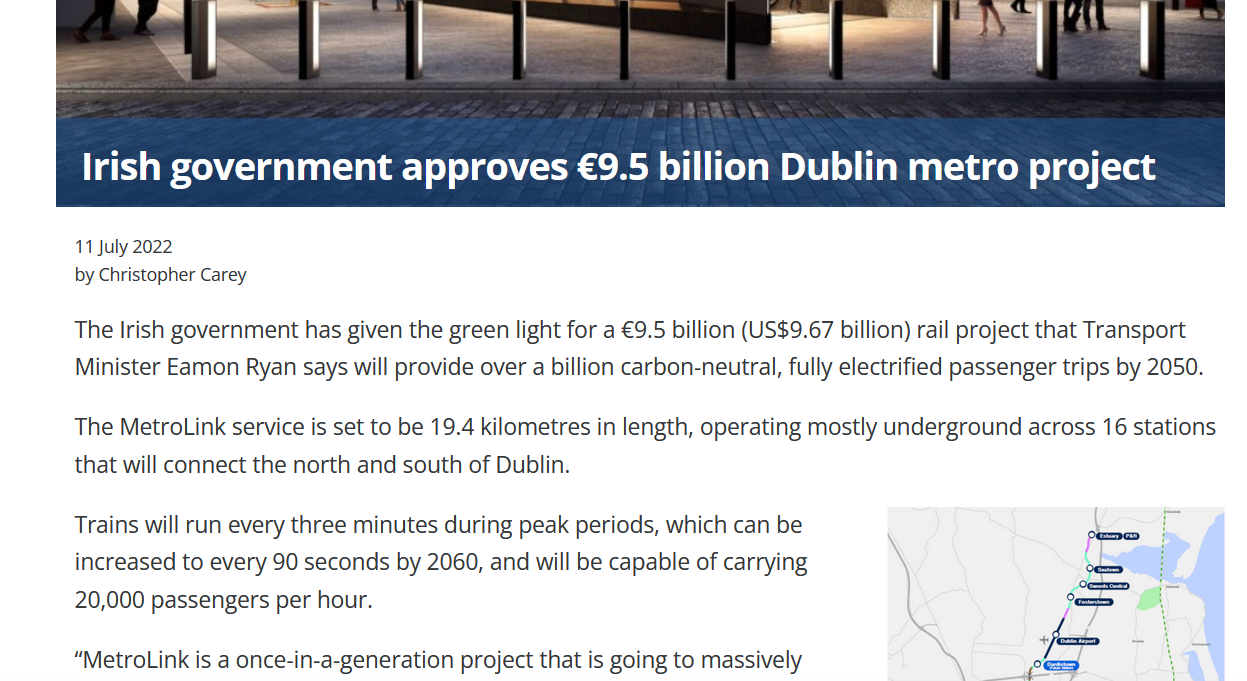The Dublin Metro
Andrew McGrath

The Government's "Transport 21" scheme, announced with great fanfare in 2006, purported to be a scheme which would rejuvenate road and rail transport in Ireland. However, aside from consisting mainly of previously announced allocations, by far the greatest share of spending was on roads, that is, motorways.
Because the
roads programme is by design centred on Dublin, Transport 21 plays the
role, on one level, of a public relations exercise, broadcasting the
illusion that large sums are being spent on public transport. The Luas
light rail system is held up as an example, even though it consists of
only two lines which do not join, and various extra lines have been
proposed for years to come . The two existing lines link up industrial
estates and land marked for rezoning, and yet cost close to ¤800
million, plus the millions spent over the years they spent in the
planning stage. At a deeper level, however, Transport 21 is designed to
permanently sink the idea of rail transport. While undoubtedly
excessive, the sums spent on prestige projects such as Luas, and the
proposed Dublin Metro, are in reality insignificant beside the billions
sunk with great alacrity into building a motorway network radiating from
Dublin.
The Dublin Metro plan involves a line running
from Stephen's Green to Dublin Airport and Swords, with a fork to
Blanchardstown, Liffey Valley and Clondalkin, before joining the Luas
Red Line and continuing to Tallaght.
The cost of the metro system in Madrid was €50 million per kilometre (in 2002 figures), whereas the cost of the
Dublin Metro is to be €100 to €150 million and upwards. Admittedly,
Madrid used suburban extensions to an existing metro, which ruled out
the need for expensive tunneling, and the Dublin Metro is to incorporate
a total of 8.5 km of deep bore tunnel. But this solution was chosen in
favour of Iarnród Éireann's proposal to run a spur to the airport from
the existing DART line, which would have achieved integration at much
less expense. Indeed, if the Metro should ever proceed, Dublin alone
will have four different rail services, none of which integrate in any
systematic way. The rest of the country is expected to be content with
the expenditure of €7.2 billion on the Metro (according to an answer by
the Transport Minister to a parliamentary question in 2002), in addition
to the billions being spent on roads designed to facilitate access to
and from Dublin to "the regions".
But there are other problems. A major issue
is why a metro link to the airport is being proposed at all. The idea of
a metro is to transport commuters to and from different parts of the
city and its associated suburbs, and in other cities with established
metro systems, for example Brussels and Vienna, this is how they
operate. In these cities there are no clumsy attempts to justify the
existence of on-street rail systems that fail to serve established
destinations, as with the proposed Metro link to the Luas Red Line. To
build a link from the city to the airport is self-defeating, as most air
passengers prefer to travel directly to and from their homes and the
airport. The proposed airport Metro station is to be almost a kilometre
from the terminal proper, meaning that even this aspect of the "airport
link" is self-defeating. So the question, as with the motorway scheme,
is what purpose the Metro scheme serves.
Unlike the motorway network, which is designed and executed to create dependence on cars and thus exacerbate urban sprawl and insensitive rural development, the Metro is not intended to go ahead. Even though Transport 21 has been prepared in the same manner as the National Development Plan (the motorway scheme), i.e., primarily as public relations and with no serious attention to cost, the difference is that such schemes as Luas and the Metro, with their unnecessarily high costs, disruption and lack of integration with other schemes, are intended to discredit rail as a transport option, and thus clear the way for the elimination of any public transport not road-dependent. Thus both the Dublin-centred motorway scheme and prestige projects such as Luas and the Metro serve the same political purpose. Luas and the Metro are not meant to go anywhere, just as the DART plan was not completed. No objection is to be allowed to the pouring of huge sums into greenfield motorways.
© The Tara Foundation, 2007